Also: see details of Chadar Expedition in January 2012, lead by tour leader Manish Lakhani
I am just back from a fourteen-day trek in Ladakh, walking on the ice-shelf of Frozen Zanskar River. They were fourteen amazing days of walking in the depths of the narrow gorges through which the river often flows. The beautiful and clear blue river flowed gently next to us all the way, sometimes disappearing into the depths of the ice shelf and again emerging a little while later. To each side of the river were tall walls of Zanskar Ranges that cut us off from rest of the world. We mostly walked on solid ice but sometimes climbed up the rocks where the ice-shelf (or chadar, as they usually call it) was broken. Here is a picture from the trek, taken from our camp on Day 2. More images and stories from the trek will follow in the coming days.
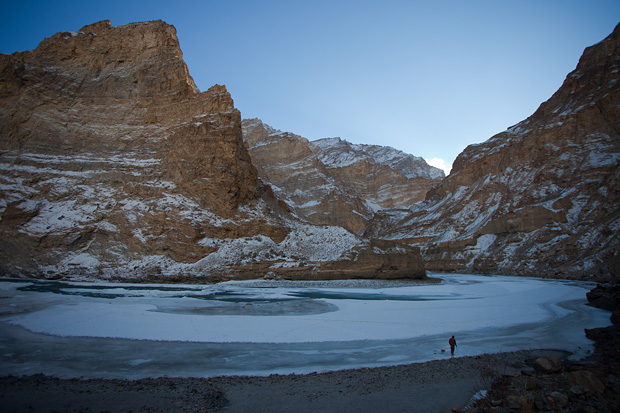
On visiting the villages of Dha and Hanu, we realized having fallen into a tourist trap. But we did manage to get the best out of the two days spent in the area.
Dha-Hanu region became a dot in the tourist map because of its people. Brokpa or Dards, as they are called, speak a different language than Ladakhis. They have a culture different from Ladakh and are a small community of just two thousand people surviving in the western part of Ladakh. But the single fact that has become a selling point for travel agents is that they wear very different clothes. Or that’s what we were told.
Perhaps Dha-Hanu was never a part of tourist’s itinerary when Ladakh was initially opened to people outside. Let me think of the sequence of events that would have helped Dha make the mark: some anthropologists would have toiled hard to dig out details of a community that the world had forgotten. They would have spent a year or two studying their way of life and their origins to publish a scholarly paper. Some enterprising men would have picked up interesting facts from these papers, taken photographs of women in traditional clothings and sold it to tourists in Leh. Some adventurous backpackers would have followed the trail to Dha, came back to spread the word about the last of the people who belong to an interesting community. The result: an explosion of tourists who could go extra mile to see some thing interesting or some people exotic.
When we asked around for specialties of Dha-Hanu, two things stood out. The driver who took us from Tso Moriri to Leh told us that the people here speak a different language and wore a different style of clothes. This was reiterated by further research where we learnt about this race of people who did not share the traits of people of rest Ladakh. It seemed worth making a visit. Not that the clothes they wear mattered much, but it would be worthwhile seeing more corners of Ladakh and meet more people.
As we alighted the bus at Dha, all that we saw were a bunch of men wearing shirts and trousers and women wearing salwar. That was alright. Perhaps only the elderly people wear traditional clothing. Or perhaps just elderly women. May be we have to go deeper into the village to meet a few of them.
The mystery was unraveled the next morning when we were talking to Dolma, the lady of the guesthouse where we were staying. “They wear those clothes when tourists ask for it,” she told us, “tourists usually pay them to do so and take their photographs.” It was an obvious tourist trap. It is so overdone that now it is a common and accepted routine for tourists to visit Dha – Hanu, have some locals to wear their traditional clothes, take photographs and go back. Dolma asked us later if we weren’t planning to do it. We weren’t. When I casually took a picture of a lady at the village (who was in her everyday clothes) later that day, she came to me and demanded that I pay up. Uncomfortable with taking pictures of an unwilling person (and not wanting to pay), I decided to delete the image instead. But another lady we met a little later was more willing.
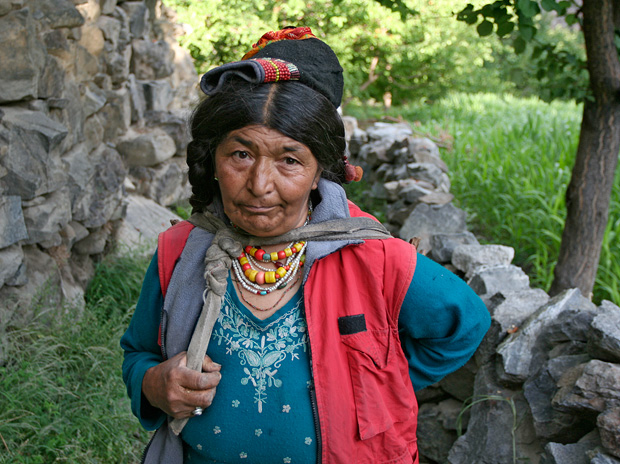
People here do look like they belong to a race different from Ladakhis. They look more Central Asian and less mongoloid. They are also more modernized than rest of Ladakh. Although they are Buddhist, they are less devoted than Ladakhis and the monastery in the village doesn’t seem to be well attended to. A French anthropologist who was at the guesthouse gave us some idea about the complex system of relationships between people in their society, which seemed very convoluted and was much different from polyandric society that Ladakh used to be.
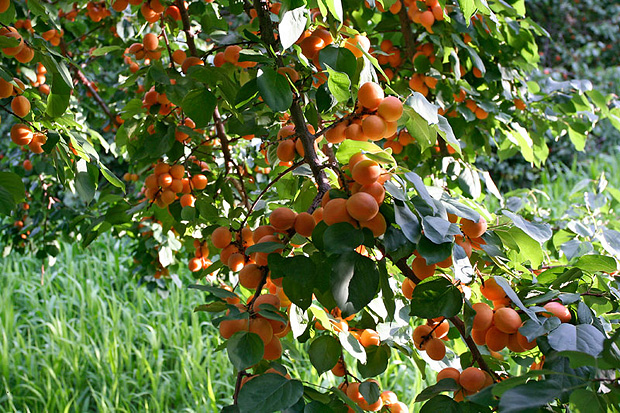
An apricot tree, fully loaded.
There is a visible difference in the attitude of people as well. The smiling faces and jubilant ‘julleys’ that you encounter everyday in Ladakh was missing in Dha-Hanu. But what they lacked in cheerfulness, they made up in their hospitality. At Baldes, a nearby village, we were invited for lunch by a kind lady whom we met on the road. As we walked back from her house later in the day, another man whom we met on the way called us in to have some snacks. A lady whom we met a little further on the road invited us for tea. I don’t remember any place, even in the hilly regions full of large hearted people, where every stranger you meet invites you home for refreshments.
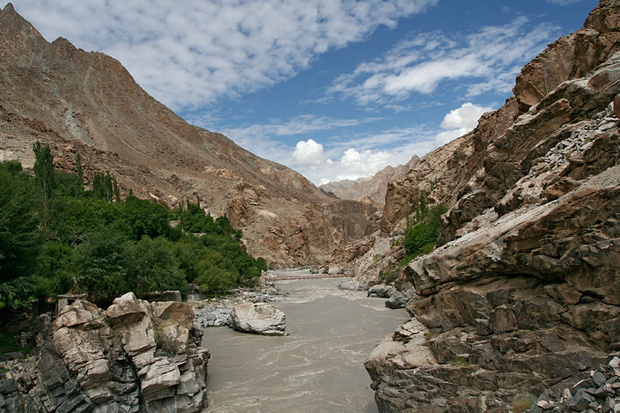
River Indus at Dha
But Dha is not just about its people. We had fallen in love with the village the moment we took the narrow path from the bus-stop to the village. The place was covered in lush greenery unseen anywhere else in Ladakh. Everywhere I see, branches of apricot trees were drooping with ripened fruits. The vegetable gardens spread all over the village were covered with cauliflowers and cabbages ready to be plucked. Even in the guesthouse where we stayed, ripe grapes were waiting to be plucked right at the courtyard. I could reach ripe apricot fruits just by stretching my hand from a window. It was so beautiful that I did not have to care what the people here wear.
The mountain slopes here are steep and are a rich hue of brown. River Indus flows swiftly next to the village in a narrow canal, sometimes so narrow that I wonder how it manages to hold all its waters in such a small space. Dha was worth a visit even when it turned out to be a tourist trap. It was two days well spent even when we did not bother to pay people to pose for us with their traditional attire.
Prints of all the images available. Request for prints.
I am often told that when you desire something strongly, the entire universe conspires to give it you. I do not know if the universe does so, but a group of unknown travelers certainly took care of something that was bothering me.
Despite having planned two months in Ladakh, we still could not fit Tso Kar anywhere in our itinerary. We had given up on it and consoled ourselves with a ‘there is always a next time.’ After spending four days in Tso Moriri and witnessing the celebrations at Korzok Gustor Festival, we were searching for transport back to Leh. We had hired a one-way transport to Tso Moriri and had left the return journey to chance. Now we were asking everyone in the village if there is a vehicle leaving for Leh tomorrow with two seats to spare.
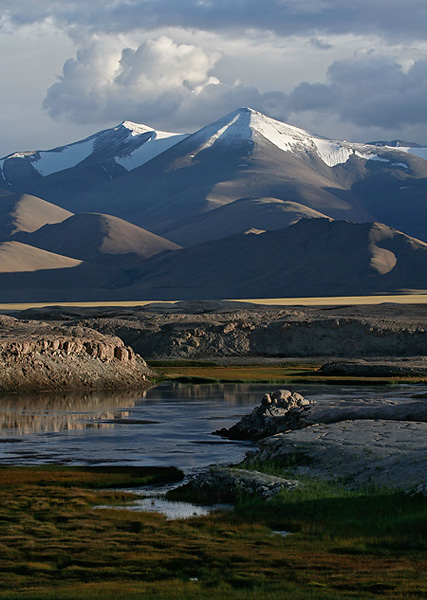
Tso Moriri is a place far away from everywhere else. Not everyday can you expect to find a vehicle heading out of the village. The one bus that connects the lake with Leh operates once in every ten days, and that tenth day was still far away. Our hope was in connecting with tourists returning to Leh, who may have some additional space available in their cab. We inquired everyone whom we bumped into and left a message at the restaurant where we always ate. That’s how we stumbled into a group of four Israeli travellers who were planning to leave the next day. The good thing: they wanted to take the longer route to Leh and spend a night at Tso Kar on the way. We could not ask for more.
—
Journal entry on the brief visit to Tso Kar.
The road to Polo Kongka pass is a smooth ascent. It almost feels like driving on a plateaued land. Unlike the dry lands of Ladakh that we are so used to until now, there is a lot of grass and greenery all along the way. We occasionally stumble upon road workers and tents of changspa nomads. A steady descent from the pass takes us to Tso Kar lake in the middle of a wide, flat terrain.
Tso Kar is not an expanse of blue waters like Tso Moriri and Pangong. It is more of a marsh in a wide valley with deep waters here and there. It is miles wide and so long that I can’t see the other end. After being used to the constantly undulating terrain in Ladakh for a month, seeing such a vast flatland comes as a surprise.
The grass around Tso Kar is tall and grows densely at places. There is plenty of bird life along the lake. We see kiangs, the Tibetan Wild Asses, getting on their feet and sprinting away at the first sight of us. Tall snowy peaks dominate the western bank while the peaks to the south are smaller and have an reddish-brown hue.
Tujhkse, a small village on the bank of the lake, appears devoid of people but for a couple who run a parachute-tent restaurant. They show us to one of the several houses with signs that read ‘home stay.’
We left early next morning, driving through Morey Plains and Tanglang La. In our earlier journey on this road when we were arriving from Manali to Leh, it was already dark when we crossed Tangland La. This time we get to see the landscapes that we had missed earlier: another wish fulfilled by the conspiring universe. The mountains here are rocky and unlike the loose soil on the slopes in most parts of Ladakh. The rocks are dark and have unusual hues varying from maroon to chocolate brown. There are queer formations all over the mountains – super sharp and jagged ridges; peaks shaped with sharp upward projections like tridents put next to each other. They are often so steep that they project like walls of rock on either side of the road.
We made the downhill journey after Tanglang la quickly and were back in Leh before noon.
Prints of all the images available. Request for prints.




